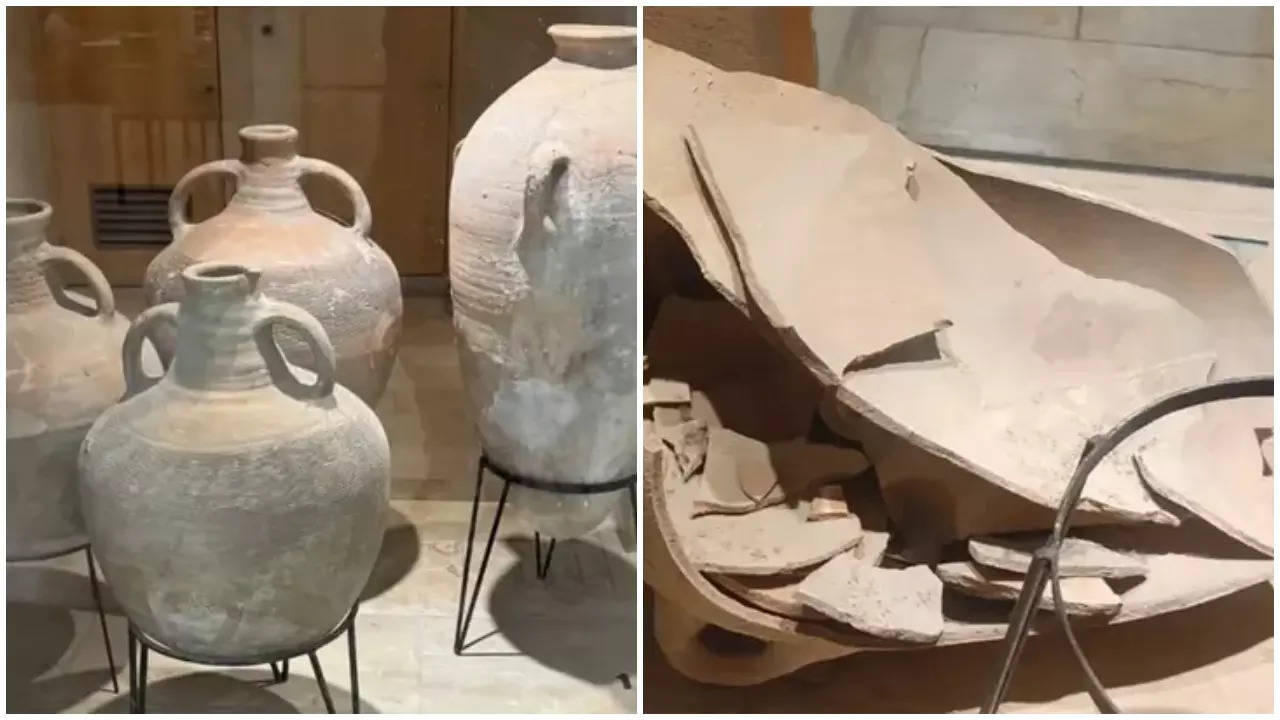A jar used for oil and wine during the Middle Bronze Age in the ancient Canaan region prevailed for thousands of years before it was put on display at the Hecht Museum in Israel.
Last week, it was felled by the curiosity of a child.
A 4-year-old boy visiting the museum in the northern coastal city of Haifa with his parents tried to peer inside the 3,500-year-old jar to see what it contained, his father said.The object toppled from its metal stand at the museum’s entrance and shattered, the museum said in a statement this week.
The Hecht Museum generally presents its priceless archaeological items without placing them behind glass or having them cordoned off by other barriers. There “is a special charm” in experiencing historical objects that way, the museum said, because visitors can be almost as close to the artifacts as the people who handled them in ancient times.
That approach is in line with the vision of the institution’s founder, Reuben Hecht, the museum said. But it left the pitcher susceptible to the whim of the child, who, his father told BBC, “pulled the jar slightly,” causing it to fall.
The jar dates to between 2200 and 1500 BC, predating the era of King David and his son and successor, King Solomon. Its features align with similar objects attributed to ancient Canaan, the museum said. “Similar jars have been found in archaeological excavations, but most were found broken or incomplete,” Inbal Rivlin, the museum’s general director, said Wednesday. “The jar on display at the Hecht Museum, however, was intact, and its size made it an impressive find, positioned at the entrance of the museum.” The Hecht Museum said the pitcher would be professionally restored in a process that would also be open for the public to watch.
Museums around the world have experienced the mischief or blunders of patrons colliding with art. In 2010, a woman lost her balance and fell into a Picasso at the Metropolitan Museum of Art in New York City. In 2016, a child at the Shanghai Museum of Glass pulled on a sculpture of an angel, causing it to fall. In 2017, a patron shattered an LED pumpkin at the Hirshhorn Museum in Washington. Despite the mishap, Hecht Museum will continue to display its artifacts unimpeded, Rivlin said. “There are instances where display items are intentionally damaged… In this case, this was not the situation.” The family, who was not identified, has been invited back for a visit to see the restored piece, she said.
Last week, it was felled by the curiosity of a child.
A 4-year-old boy visiting the museum in the northern coastal city of Haifa with his parents tried to peer inside the 3,500-year-old jar to see what it contained, his father said.The object toppled from its metal stand at the museum’s entrance and shattered, the museum said in a statement this week.
The Hecht Museum generally presents its priceless archaeological items without placing them behind glass or having them cordoned off by other barriers. There “is a special charm” in experiencing historical objects that way, the museum said, because visitors can be almost as close to the artifacts as the people who handled them in ancient times.
That approach is in line with the vision of the institution’s founder, Reuben Hecht, the museum said. But it left the pitcher susceptible to the whim of the child, who, his father told BBC, “pulled the jar slightly,” causing it to fall.
The jar dates to between 2200 and 1500 BC, predating the era of King David and his son and successor, King Solomon. Its features align with similar objects attributed to ancient Canaan, the museum said. “Similar jars have been found in archaeological excavations, but most were found broken or incomplete,” Inbal Rivlin, the museum’s general director, said Wednesday. “The jar on display at the Hecht Museum, however, was intact, and its size made it an impressive find, positioned at the entrance of the museum.” The Hecht Museum said the pitcher would be professionally restored in a process that would also be open for the public to watch.
Museums around the world have experienced the mischief or blunders of patrons colliding with art. In 2010, a woman lost her balance and fell into a Picasso at the Metropolitan Museum of Art in New York City. In 2016, a child at the Shanghai Museum of Glass pulled on a sculpture of an angel, causing it to fall. In 2017, a patron shattered an LED pumpkin at the Hirshhorn Museum in Washington. Despite the mishap, Hecht Museum will continue to display its artifacts unimpeded, Rivlin said. “There are instances where display items are intentionally damaged… In this case, this was not the situation.” The family, who was not identified, has been invited back for a visit to see the restored piece, she said.
Source : Times of India









